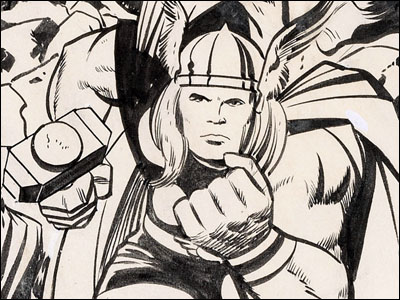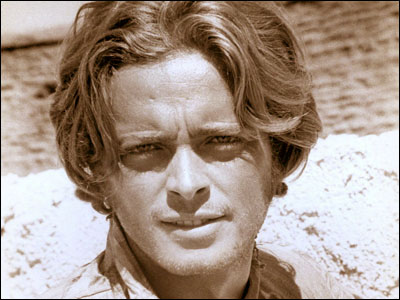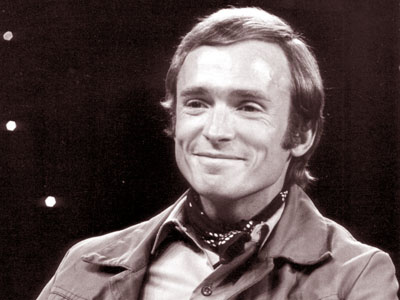
Over on his blog, Eddie Campbell defends the much-maligned Vince Colletta, the late comic book artist whose work is so vilified these days by connoisseurs. I guess I'm one of the main vilifiers and I'd be lying if I said I'm ashamed of that. In fact, I don't think I've ever gotten through a major comic convention without someone coming up to me and bestowing thanks for my role in getting Jack Kirby to dump Colletta as his inker around 1971. It could easily be my greatest contribution to the world of comics…not that it has a whole lot of competition for that distinction.
Jack never thought Colletta did anything but poor work but he also believed that everyone has to make a living. He also felt that inking wasn't all that important. Even a bad inker — and Jack had many — usually retained the essentials of the storytelling, which is what Jack felt comics were all about. Being a Depression-era kid, he required a little urging before he felt at ease about taking away a source of income from someone else.
(I'd also be lying if I took major credit for him finally making the switch. What really pushed Jack to replace Colletta was the inker's personal behavior. Vince was showing Jack's finished DC art around the Marvel offices, despite being admonished not to do that. More significantly, when Jack and Vince had an in-person meeting about their working relationship, Colletta offended Kirby with his attitude, which Jack said was along the lines of, "Hey, for what this company pays, I just knock it out as fast as I can and you should do the same.")
I agree with Eddie that Colletta's reputation these days suffers from the poor reproduction his work gets in reprint volumes. Everyone's work is diminished somewhat but because of the fine lines Colletta so often employed, his suffers more than most. No disagreement there.
However — ah, you smelled a "but" coming, didn't you? — I've seen the original printings. I have almost every one of them from the sixties, at least at Marvel. I've also seen more Kirby original art, before and after Colletta got hold of it, than most people, and I still think that the good art was good in spite of what Vinnie C. did to the pages, not because of him. Everyone's entitled to like what they like and if Eddie liked it, fine. He's certainly not alone in that viewpoint. As I wrote in an article in The Jack Kirby Collector, Colletta had a lot of fans, not just on his work over Kirby but on many of the comics he handled. But let's not pretend that those of us who don't like Colletta's inking are merely being deceived by faulty reproduction.
Moreover, I think Campbell is skirting the main reason that among comic fans, Colletta's name is about as revered these days as ol' Doc Wertham's. It's that almost all the top illustrators whose work was inked by Colletta are on record as saying they thought he was terrible.
Kirby got rid of him. Alex Toth and Neal Adams both demanded that he never darken their pencils again. (Adams took the one job of his Colletta inked and personally retouched about 80% of it without compensation.) That was just in the early seventies, at a time when artists rarely demanded such a thing…but what Vinnie did drove Jack, Alex and Neal to break precedent. And Jack, Alex and Neal were arguably the three best artists then working in comics. Steve Ditko and Gil Kane — who may well qualify as the rest of the Top Five — made similar demands.
Since then, others have admitted that they would have barred Colletta from embellishing their work if they could have. Just on convention panels I've moderated, we heard that from Gene Colan, John Buscema, Bob Oksner and Marie Severin. At one panel I hosted, someone asked what tool Colletta inked with and instantly, John Romita (yet another great artist) piped up with "A whisk broom," and added that one of the perks of his position as Marvel's Art Director was that he could make certain his work was not inked by you-know-who. Joe Orlando, who was an editor at DC during the same period, told me the same thing. He'd been inked by Colletta before, back when he couldn't prevent it, and wasn't about to let it happen again. Carmine Infantino, another great artist, was then running DC. Infantino didn't pencil much during the period but what he did draw didn't go to Colletta for inking, either.
So it isn't that the fans didn't like Colletta's work. It's that the guys being inked by Colletta thought it was awful and some of the guys giving out the work weren't all that fond of him, either. Colletta had more admirers among the readers. Campbell also displays some samples of alleged Colletta romance art from 1954 to defend the guy. I say "alleged" because a lot of what Colletta signed during this period was ghost-pencilled by others — so much so that I'm not sure which examples, if any, actually reflect Vinnie the Artist, as opposed to Vinnie the Guy Who Had Plenty Of Assistants. But even if Campbell's selections are pure Colletta, what does that prove? That the man could have done better work later on but chose not to? That he was simply miscast in all his later work? There might be something to that latter thought but it doesn't make the thousands of pages he inked over other artists any better.
Yes, Colletta's speed and reliability did save a lot of deadlines when books were running late. But most of what he did in comics was not done on that basis and he delivered the same low level of craftsmanship when the work wasn't in danger of missing a printer's deadline. Kirby was way ahead of the deadlines on Thor for most of its run. It's doubtful Colletta ever had to ink an issue of that comic overnight.
Yes, he was fast and he was cheap. A guy like that can be invaluable…but no one is arguing that editors didn't have a reason to keep him around. We're just arguing that what he did wasn't very good.
And yes, Colletta could be a charming guy. No one's arguing that, either…but hey, I can be a charming guy and I'm not good enough to ink Jack Kirby, either, as I proved on a couple of occasions. Actually, another reason that Colletta is not well-liked within the industry is that he had a tendency to ingratiate himself with the top guy at the company and then to use that clout to put even less effort into his work. When Jim Shooter was ousted as Editor-in-Chief at Marvel in 1987, Colletta found himself simultaneously on the outs with the editorial staff and wrote an infamous open letter denouncing them for what he saw as their disloyalty to Shooter.
To understand the letter, you kind of have to understand that in the year or three prior, Colletta had routinely enraged Marvel's editors by handing in not only poor work but work that was incomplete. He was "in tight" with the boss so he would deliver pages with no backgrounds, or with some of the inking unfinished, and tell the editor, "Have the staff guys finish it up."
When Shooter was let go, all the Marvel editors stopped giving Colletta work. In his letter, he made out like it was punishment for his allegiance to Shooter…but a number of freelancers who'd been friendly with Jim kept right on working for the company. No one else suddenly lost all their work. The reason Colletta was let go was that all the editors had long since come to dislike him and/or his inking. With Shooter gone, they were finally free to replace Vinnie…and all did so immediately. That's what happened there.
Now, if someone wants to argue that this was editorial misjudgment…well, okay. You duke it out. I'm not particularly interested in that argument, nor will I debate someone who thought Colletta did fine, fine work. Certainly, many felt that way and still do. My opinion is just my opinion. I could even make the case that for most of his career, Colletta did work that was quite acceptable to many of his editors and that you can't fault a guy too much when that's the name of the game. Hell, I could even argue that for what the industry paid at the time, Colletta was earning his money, delivering the level of service that the page rates warranted.
My quarrel here is merely with the excuses that the poor work was due to him always having to do work in a hurry, or that Colletta is now much-maligned because fans know his work only from the poor reprints. His bad rep flows from Neal Adams calling him "the worst inker ever in comics" and other such comments from his peers. And also from a lot of us who looked at the work and simply felt Vinnie ruined an awful lot of great comic art.





